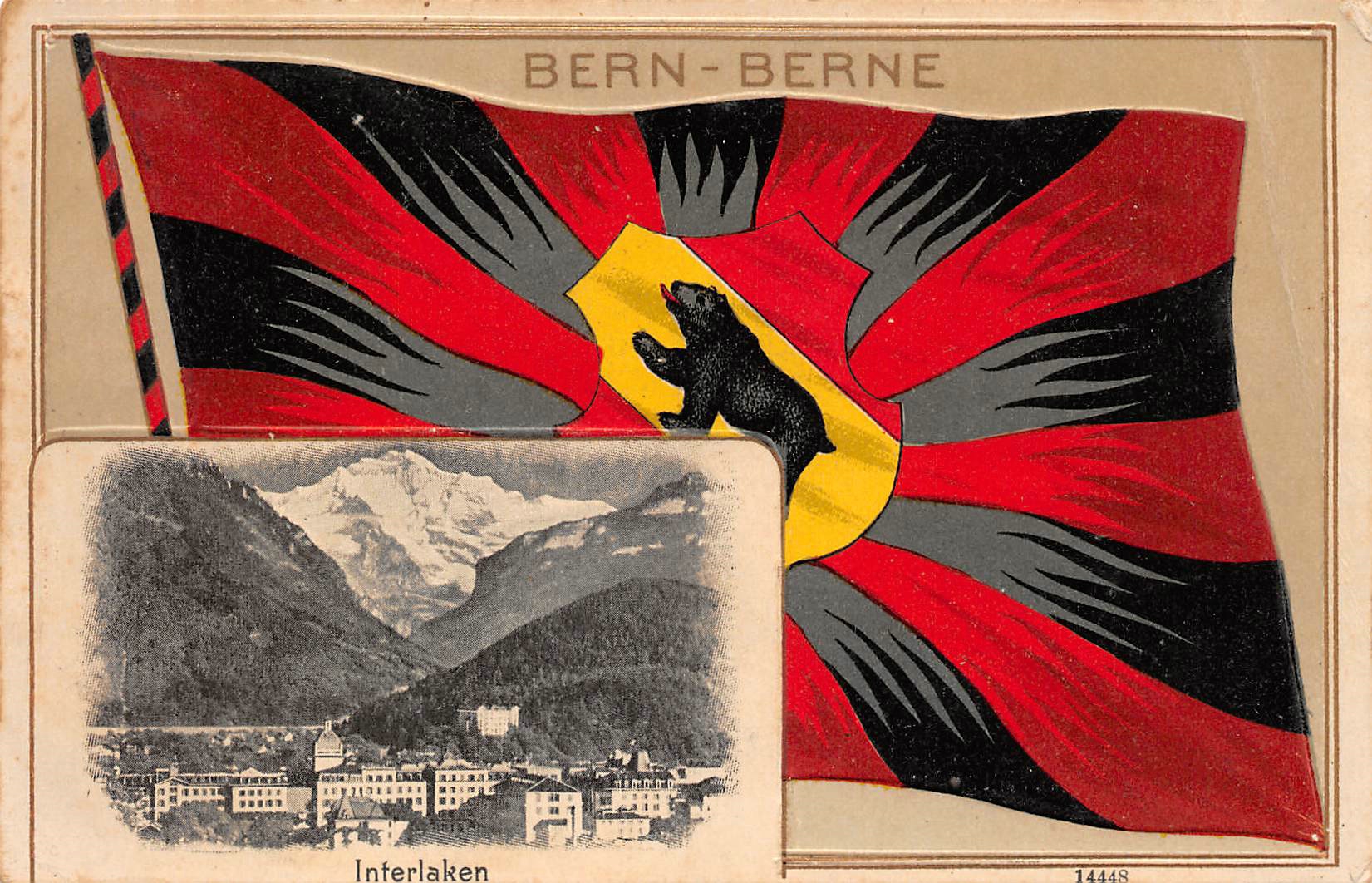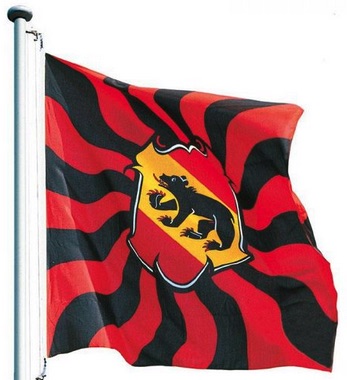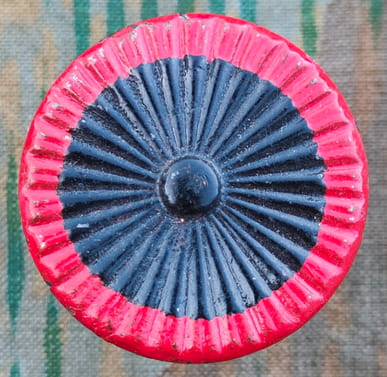Flaggen, Knatterfahnen and Livery Colours
![[Knatterfahnen]](../images/c/ch-be_kf.gif)

Last modified: 2025-04-12 by martin karner
Keywords: switzerland | bern | berne | bear | bend | german | french |
Links: FOTW homepage |
search |
disclaimer and copyright |
write us |
mirrors
![[Flag of Bern]](../images/c/ch-be.gif) image by T.F. Mills
image by T.F. Mills
Description of the Flag
Gules, on a bend or, a bear passant sable, langued, armed and vilené
of the field.
On a red field a yellow diagonal band charged with a black bear
walking upwards toward the hoist. It is important to note that the
official "blazon" specifies that the tongue, claws and penis are red
– and by extension it is important to always depict the bear as
male.
T.F. Mills, 18 October 1997
Symbolism of the Flag
The bear is one of the oldest religious and totemistic symbols. It
dominated Switzerland in prehistoric times, and although now extinct [It was extinct from 1904 to
2005 – ed.] is still considered the king of beasts in the region. The city of
Bern maintains to this day a bear pit to perpetuate the symbolism of
its name, but the bears are imported. The red and yellow field are
thought to have come from the Holy Roman Empire battle flag, which
was "per pale gules and or" (divided vertically red and yellow).
T.F. Mills, 18 October 1997
History of the Flag
Count Berchtold V of Zahringia founded the city of Bern in 1160.
According to legend he killed a large bear in the forest near his
new town and named the town for the beast. The city's flag was
originally white with the bear in its current diagonal position.
After the battle of Schlosshalde in 1289, the flag was changed to
its current red and yellow form. The red in the new flag is
sometimes said to represent the blood of the men who died in that
battle defending the old banner. The first documented evidence of a
Bern flag is in 1208, and the current one certainly dates from no
later than 1365. The maleness of Bern's bear was officially
established by law in 1957.
Bern became a sovereign state in the Holy Roman Empire in 1226, and
joined the Swiss Confederation in 1353. Bern was a major imperial
power, conquering neighboring areas and forming its own regional
alliances (including expansion into French-speaking areas) before it
joined the Swiss. It remains today the second largest canton even
after the loss of territories which seceded. Since 1848 the city of Bern has been
the federal capital (From 1798 to 1848 Switzerland had a weak
confederate government with rotating institutions, and prior to 1798
there was virtually no institutional evidence of a Swiss
Confederation).
T.F. Mills, 18 October 1997
– Oldest known depiction of Bern's arms on a city seal from 1224 (source).
Oldest known coloured depiction on a shield from the 14th century (source).
– Stained glass plate (Ämterscheibe, ca. 1500), with CoA of 25 bailiwicks (for names and info see source). –
– Shooter flag, reverse, carried in the Burgundian Wars (1474–77) (source: [b7b42]).
– Stained glass plate (1554), by Carl von Egeri, with two warriors in
armour and flag of Bern. On the upper part two Biblical scenes with Samson (Shimshon) fighting with the lion and
carrying away the gate of Gaza (Judges 14:5+6; 16:3). Location: Historical Museum of Bern (source).
– Allegory on the State of Bern (1682), painting by Joseph Werner.
Created as decoration for the Grand Council chamber. Berna, the personification of the Republic, is
protected by bears and surrounded by Faith and Prosperity (source).
– Bernese infantry flag (drawing), first half of 18th c. Location: Swiss National Museum, Zurich (source).
As noted on the Jura page the Jurassian flag was approved in 1951 by the Bernese government as the flag of all
seven Jurassian districts (hence the seven stripes on the flag). In May 2020 Anne-Caroline Graber, member
of the Bernese cantonal parliament, wanted to know from the government, if the Jurassian flag is still in
force for the three southern districts, which had decided (together with the German speaking Laufen as fourth
district) in 1975 to remain in Bern – whereas the decree from 1951 never has been repealed officially.
The government answered that the flag hadn't been repealed indeed, but suspended in 1976 until a final
decision would be made (i.e. the creation of a new canton). However, to the executive's knowledge, no
other measure has been taken since, probably "because of the absence of any necessity whatsoever",
as it wrote. The government does not see the need to do so today. It recalls that the current
administrative districts still do not have specific coats of arms and flags. No flag is actually valid
for the Bernese Jura as a whole.
Sources: News article,
Wikipedia article with 1951 decree (German)
Martin Karner, 21 December 2023
![[Colour Flag BE]](../images/c/ch-be_56.gif) image by Ole Andersen/António Martins
image by Ole Andersen/António Martins
Simple rectangular cantonal flag, as shown in Kannik (1956) [So-called colour flag (Farbenfahne in German)].
Ole Andersen, 4 August 2002
See also: STATE COLOURS in Dictionary of Vexillology
Flaggen, Knatterfahnen and Livery Colours |
![[Knatterfahnen]](../images/c/ch-be_kf.gif)
|
Flaggen are vertically hoisted from a crossbar in the manner of gonfanon, in ratio of about 2:9, with a swallowtail that indents about 2 units. The chief, or hoist (square part) usually incorporates the design from the coat of arms – not from the flag. The fly part is always divided lengthwise, usually in a bicolour, triband or tricolour pattern (except Schwyz which is monocolour, and Glarus which has four stripes of unequal width). The colours chosen for the fly end are usually the main colours of the coat of arms, but the choice is not always straight forward.
Knatterfahnen are similar to Flaggen, but hoisted from the long side and have no swallow
tail. They normally show the national, cantonal or communal flag in their chiefs.
Željko Heimer, 16 July 2000
See also: HANGING FLAG, VERTICALLY HOISTED FLAG, LIVERY COLOURS in Dictionary of Vexillology

 images located by Martin Karner
images located by Martin KarnerAt the beginning of the 20th century, flamed flags were still in use, with the white cross replaced by
a (baroque) shield in the centre of the flag. These decorative flags had been used until WWII and then
somewhat forgotten in preference of the current cantonal flags. [Today they are being
produced again, see right image]
Pascal Gross, 30 June 2002
See also:
logo.jpg) image located by Martin Karner (8 May 2024)
image located by Martin Karner (8 May 2024) image located by Martin Karner
image located by Martin KarnerCockade for the cantonal troops' headgear (regulation from 1898, size: ca. 35 mm, reverse side).
Martin Karner, 14 March 2025
See also: Cockades (Swiss Army)